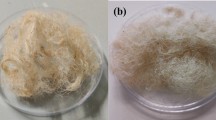Abstract
THE permanent set which strained wool fibres acquire in steam or boiling water is due to breakdown of disulphide bonds ; this promotes dissipation of stress, followed by linkage rebuilding, which fixes the relaxed structure in its deformed state. In such conditions oxidized fibres are more difficult to set than untreated, and it has been suggested that the formation of intermediate oxidation products, such as the sulphone, is sufficient to impair setting power1. This view has now been confirmed by taking advantage of the observation that sulphur dioxide can be reduced to sulphur by hypophosphorous acid2.
This is a preview of subscription content, access via your institution
Access options
Subscribe to this journal
Receive 51 print issues and online access
$199.00 per year
only $3.90 per issue
Buy this article
- Purchase on Springer Link
- Instant access to full article PDF
Prices may be subject to local taxes which are calculated during checkout
Similar content being viewed by others
References
Speakman, J. B., J. Soc. Dyers and Colourists, 52, 335 (1936).
Von Deines, O., Ann. Chem., 440, 213 (1924).
Smith, A. L., and Harris, M., J. Res. Nat. Bur. Stand., 16, 309 (1936).
Suter, C. M., “The Organic Chemistry of Sulphur” (J. Wiley and Sons, Inc., New York, 1945).
Whewell, C. S., and da Silva, M. A., J. Text. Inst., 48, T98 (1957).
Author information
Authors and Affiliations
Rights and permissions
About this article
Cite this article
WOLFRAM, L., SPEAKMAN, J. Reactivity of the Disulphide Bond in Wool. Nature 187, 595–596 (1960). https://doi.org/10.1038/187595a0
Issue Date:
DOI: https://doi.org/10.1038/187595a0
Comments
By submitting a comment you agree to abide by our Terms and Community Guidelines. If you find something abusive or that does not comply with our terms or guidelines please flag it as inappropriate.



